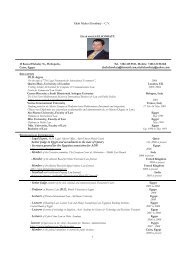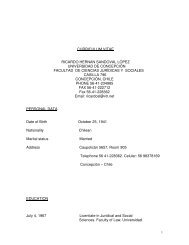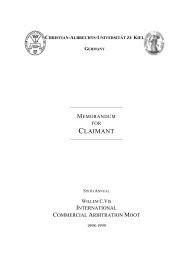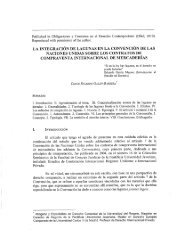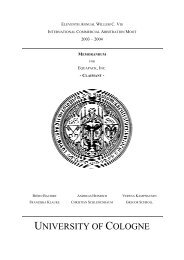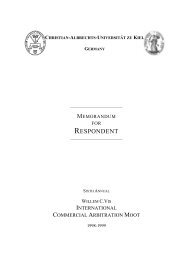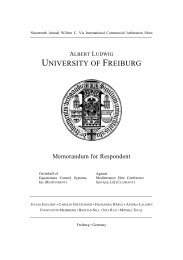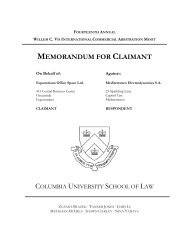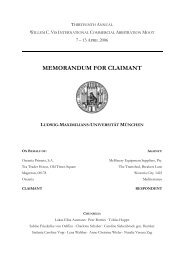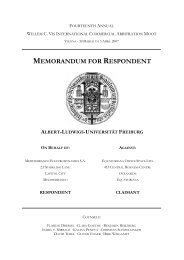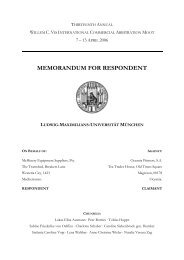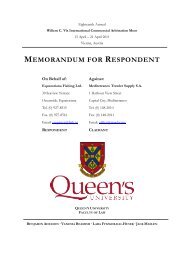Equapack, Inc. v. Medi-Machines S.A. Memorandum for Medi ...
Equapack, Inc. v. Medi-Machines S.A. Memorandum for Medi ...
Equapack, Inc. v. Medi-Machines S.A. Memorandum for Medi ...
You also want an ePaper? Increase the reach of your titles
YUMPU automatically turns print PDFs into web optimized ePapers that Google loves.
inspection, [see supra § II.A]. Even though CLAIMANT had evidence of the corrosion of the<br />
machines long be<strong>for</strong>e it reached the current extent, [Claimant’s Ex. 6], there is no evidence that<br />
CLAIMANT attempted to contact RESPONDENT or any other experts until the machines were<br />
seriously damaged. Thus it was not RESPONDENT’s actions, but rather CLAIMANT’s, that are<br />
to blame <strong>for</strong> the damage.<br />
54. Moreover, even if RESPONDENT were to blame <strong>for</strong> the current state of the Model 14<br />
machines, damages would be sufficient to compensate CLAIMANT <strong>for</strong> any harm suffered.<br />
CLAIMANT incorrectly states that it is now impossible <strong>for</strong> the machines to be put to any<br />
“reasonable use.” [<strong>Memorandum</strong> <strong>for</strong> Claimant 49]. In fact, at least two Model 14 machines<br />
are currently usable <strong>for</strong> production line packaging. [Engineer’s Report]. Moreover, even if the<br />
other four machines are not presently usable, damages could easily compensate any of<br />
CLAIMANT’s losses. Avoidance is not appropriate in such a situation.<br />
55. CLAIMANT also alleges that the purpose of its contract with RESPONDENT was<br />
“frustrated since CLAIMANT was unable to satisfy the main contract with A2Z.”<br />
[<strong>Memorandum</strong> <strong>for</strong> Claimant 48]. However, CLAIMANT presents no evidence <strong>for</strong> this<br />
proposition beyond than the bare assertion of its counsel. [See Letter of Joseph Langweiler, 24<br />
Sept. 2003]. Furthermore, even if it is true that CLAIMANT was unable to satisfy its contract, it<br />
has only itself to blame; as explained above, the damage to the machines was a result of<br />
CLAIMANT’s misuse of the machines and failure to conduct a proper inspection. [See supra <br />
53].<br />
B. No “substantial detriment” to CLAIMANT was <strong>for</strong>eseeable to RESPONDENT.<br />
56. Even if CLAIMANT were able to persuade the Tribunal that RESPONDENT caused it<br />
substantial detriment, CLAIMANT could not prove its claim of fundamental breach unless the<br />
detriment was <strong>for</strong>eseeable to a reasonable person in RESPONDENT’s circumstances. [Art. 25<br />
CISG; Duncan 1379; Koch 265]. Since none of the harm of which CLAIMANT complains was<br />
objectively or subjectively <strong>for</strong>eseeable, its claim must fail.<br />
57. Article 25 CISG does not explicitly state the relevant time <strong>for</strong> applying the <strong>for</strong>eseeability<br />
inquiry. [Gabriel 295]. The majority of commentators agree that the relevant question is<br />
whether the harm could reasonably have been <strong>for</strong>eseen at the <strong>for</strong>mation of the contract.<br />
[Enderlein/Maskow 116; Koch 266; Piche 530; Schlechtriem 180; Speidel 440-442; Will 220].<br />
19



